
Is The Mind Muscle Connection Legit?
For decades, bodybuilders have advocated for the mind muscle connection which refers to aiming your focus towards the targeted muscle you’re training.
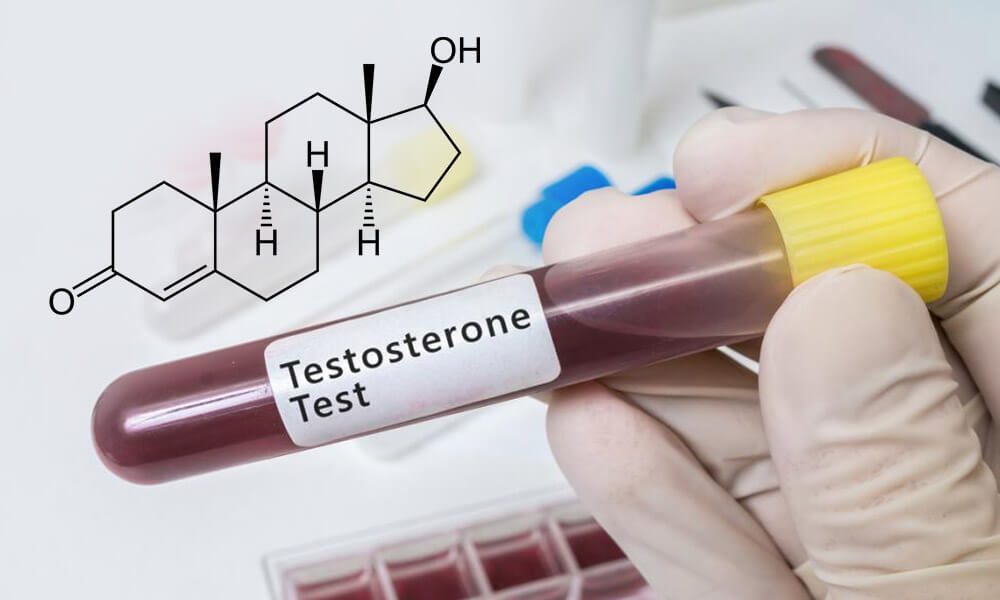
We all want epic testosterone levels coursing through our veins like Thor pulsing with lightning. Unfortunately, many men struggle with their testosterone, sometimes unknowingly.
This is partly due to lifestyle factors and unhealthy body fat levels (1). But typically speaking, after puberty, your testosterone is on a predictable decline. This drop is normal and should be small, but getting tested yearly is a good idea.
After all, there is a dose-response between testosterone and baseline muscle. So you will lose muscle/strength with major drops in testosterone, not to mention your health and libido fade as well (2).
However, increasing testosterone naturally by large margins is almost unheard of after a man turns 19. This leads me to my informal 1-year experiment.
You’ve heard all the basic advice out there. Eat a nutritious diet, don’t neglect any macro, exercise, sleep, and don’t be fat. While this stuff is more boring than watching bread collect mold, they are the low hanging fruit for boosting your testosterone. You must master these basics before even considering anything in this article.
That being said, many dedicated lifters are already doing this and still want to further increase their testosterone cause you know, why not?
For example, my testosterone levels are good. I’ve lived a healthy lifestyle and have optimized my diet, sleep, and exercise for years. However, I was able to increase my testosterone by 55% this last year during what many would describe as an extremely stressful year.
In fact, with Covid stress and business volatility, my testosterone should’ve tanked in 2020.
But the proof is in the pudding. You can see my bloodwork below. My total testosterone went from 667 ng/dL in January 2020 to 1031 ng/dL in January 2021. My doctor thought I started taking something illegal without his permission. Nah Doc, just a good Christian bro here.
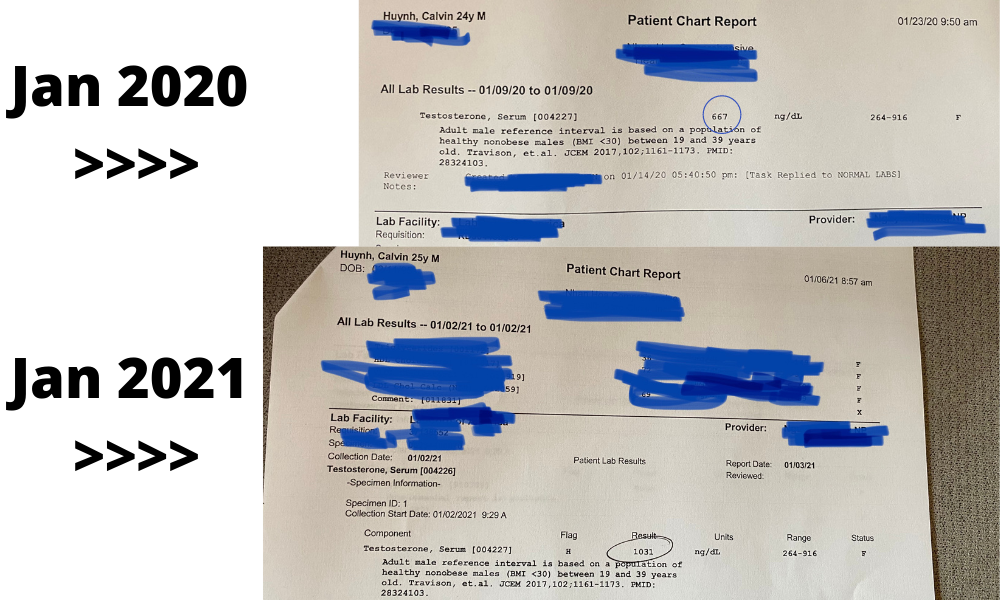
And even though I’m relatively young, this change is nothing I’ve ever seen in myself especially considering testosterone is relatively similar year to year.
So the following 3 science backed changes are what I can attribute my testosterone increase to this last year. And remember, this is with a foundation of a healthy lifestyle. Obviously, you won’t see much difference if you’re still binging on Cheetos, stressing about your ex, and have piss poor sleep schedule.
I don’t blame supplements for getting a bad rap. Many of them simply make your piss more expensive. I didn’t take many prior to this last year. But supplements can be a useful tool to give you a slight edge or fill crucial deficiencies.
In fact, most of the supplements I started taking and recommend to clients are simply basic vitamins and minerals that are too difficult to get through diet alone. Filing these gaps optimizes your health and thus will optimize hormonal production.
Here are the supplements I started taking in order of importance.
Vitamin D possesses direct and indirect mechanisms to improve your hormones including testosterone (4). Growing up as a water polo player, I thought I got plenty of Vitamin D from the sun. However, research finds many people are severely deficient (3).
Even athletes training outdoors are deficient and most vitamin D recommendations are based on basic needs not full optimization (5). For maximum benefits you need much more than recommended intakes (6). And despite what the internet will tell you, most foods don’t have much vitamin D relative to what’s optimal.
You essentially have to supplement. I generally suggest 4000-5000 iu per day taken with a meal containing fat to maximize absorption. Within a few days of vitamin D supplementation, my overall well being felt much better. This has become a cornerstone supplement I recommend to clients.
Furthermore, if you keep a watchful eye, vitamin D prices have skyrocketed in the last couple of years. I would buy it early and in bulk if I were you.
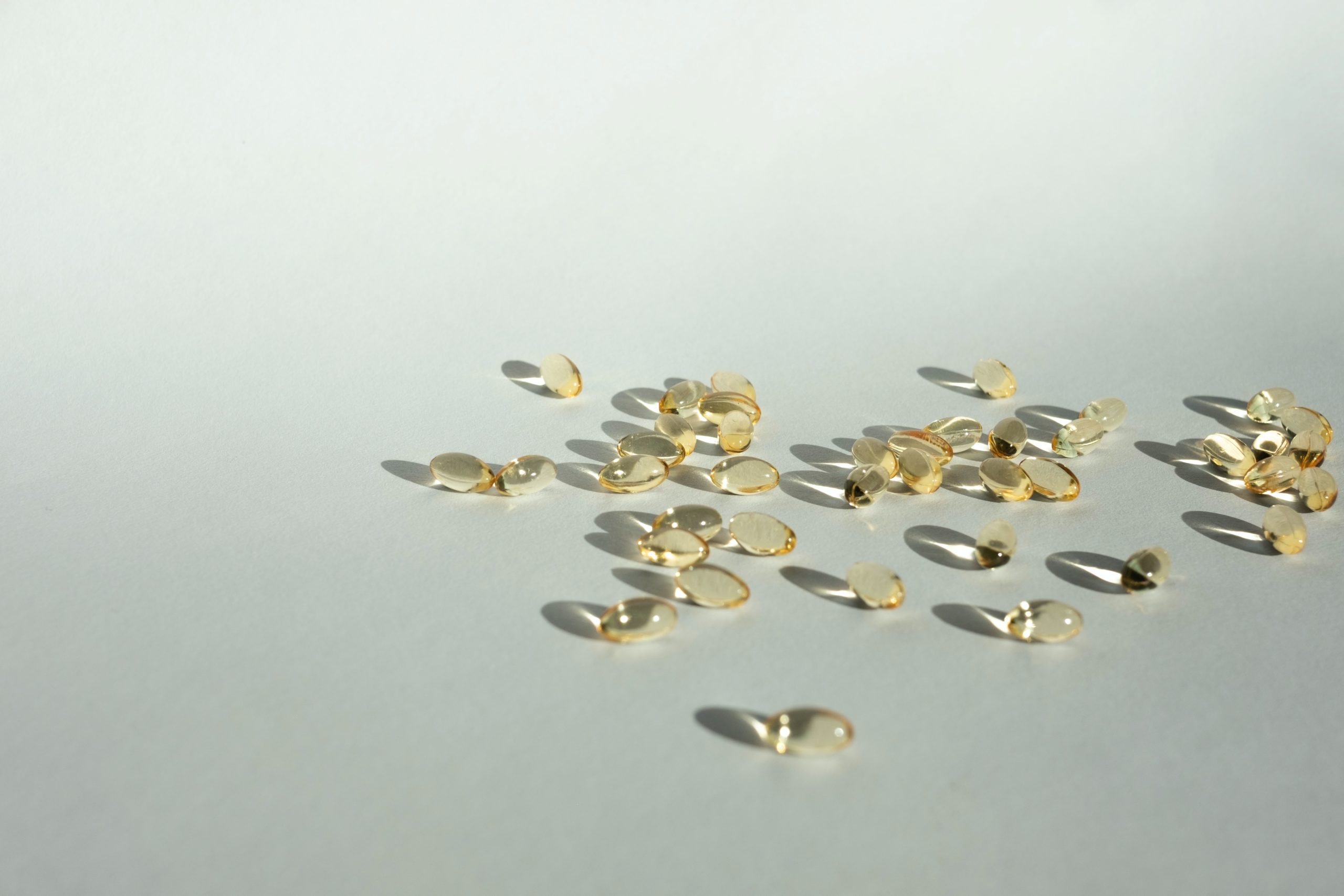
Zinc is arguably the most direct mineral to boost testosterone. It’s literally required for testicle function. Merely filling a deficiency of 5mg per day in elderly men doubles testosterone levels (7).
Many people, especially lifters don’t get enough zinc at least not for full hormonal benefits. Meatheads have more muscular demands and lose more minerals through sweat, so zinc becomes increasingly important based on your activity levels (8).
The 11 mg male and 8 mg female recommendations are weak. For full benefits, I generally suggest males get 15 mg and females get 10 mg per day.
The upper tolerable limit is 40 mg. Overdosing on zinc can come with nasty side effects like nausea, vomiting, and headaches. That being said, the side effects only occur with supplementation not food. Plus, it’s profoundly difficult to reach 40 mg with food alone unless you live in an oyster buffet.
So I’ve been taking a low dose zinc supplement while mindfully eating more zinc rich foods like red meat, scallops, mussels, oysters, fortified cereals, and peanut butter powder.
If you choose to supplement, I generally suggest no more than 10-25mg per day.
Magnesium regulates hundreds of processes in the body (9). Magnesium deficiency causes the following noteworthy detriments:
And because magnesium plays direct a role in muscle recovery/repair, it’s particularly important for lifters and athletes, especially considering magnesium is loss via sweat (10). Current RDA is 400 mg for men and 310 mg for women, so lifters should aim for 100 mg more than this as a minimum.
Unfortunately, magnesium is a bit difficult to get from food alone. It’s found in decent amounts in nuts, seeds, oats, spinach, legumes, potatoes, bananas, and fish.
Because you simply pee out excess magnesium, there’s relatively no harm in supplementing on the high end. I started taking a few hundred mg each night before bed to have my bases covered and recommend the same for most clients.
It has a slight relaxing effect, so it may even help you sleep better which can support hormone production. It’s also an electrolyte which I regret not bringing with me on a recent road trip where I noticed more muscle cramps.
Oh and before I forget, make sure you don’t take magnesium oxide (11). That’s the cheap stuff that your body barely absorbs. Use other forms like magnesium citrate or magnesium glycinate.
Ashwagandha is an adaptogen meaning it helps fight stress. It’s name translates to smell of horse and unsurprisingly tastes pretty bad. For that reason, pill is preferred over powder if you’re willing to pay a bit more.
Studies show ashwagandha can increase testosterone, but these were done in overweight and/or stressed men (12,13). We don’t know if it would apply to healthy men.
Nonetheless, ashwagandha can improve exercise performance, while reducing stress and anxiety (14). These are all good things for your testosterone. It’s particularly effective in cortisol or stress prone individuals.
I take 1000 mg per day which seems to be the higher end used in research.
Grab my Lifter’s Guide to Managing Stress
Mouth breathing is an epidemic. I used to be a massive mouth breather, so I doubled down on breathing through my nose.
While nasal breathing doesn’t directly increase testosterone, it can increase IGF-1 production and improve sleep which can increase testosterone (15).
In fact, nasal breathing is the way the body is designed to breathe. The only times you should ever have to breathe through your mouth are during high stressed situations like strenuous exercise, giving birth, or fighting a dragon.
Apart from that, you need to maximize recovery and well-being by breathing through your nose. This calms down your nervous system, reduces stress, and maximizes oxygen into your bloodstream.
It also filters bacteria better so you’re less likely to get sick which is never good for your hormones (16).
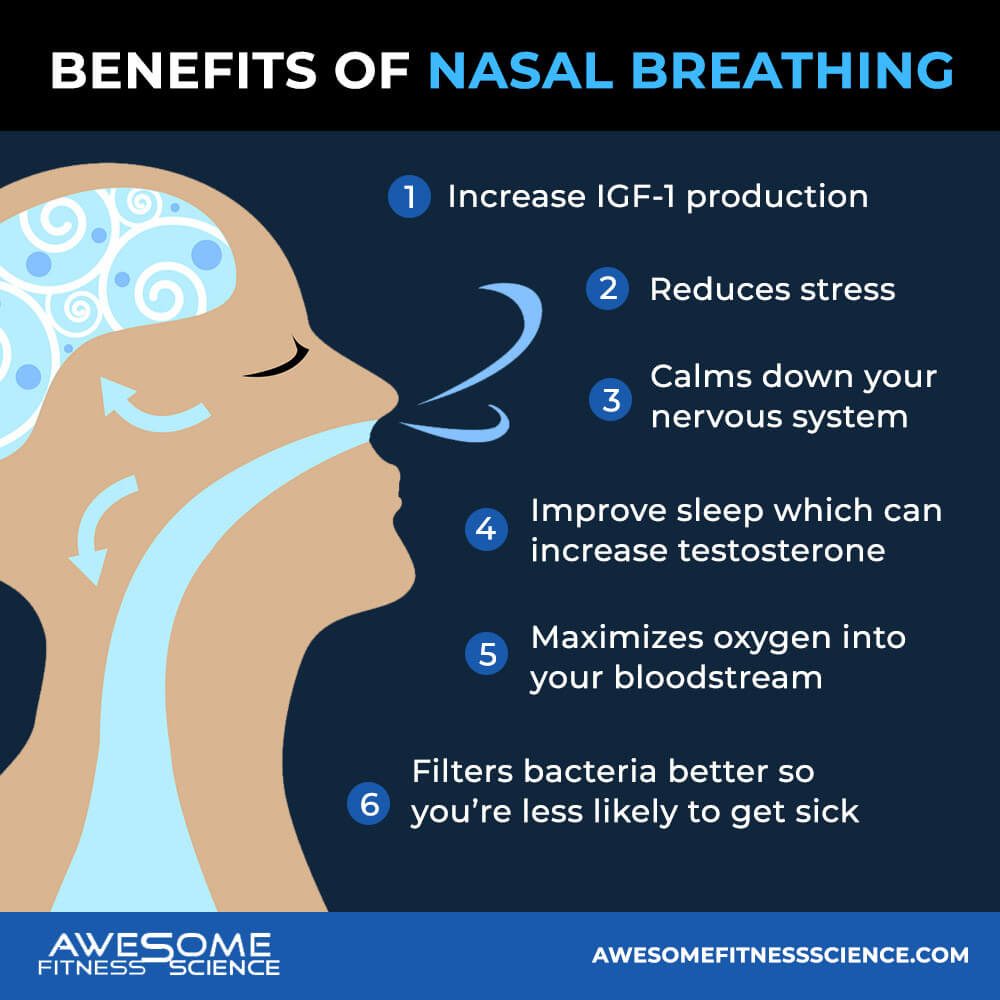
To convert to more nasal breathing, here are some personal suggestions I have:
Nonetheless, nasal breathing has been a game changer. It will reduce your stress and improve your sleep which is great for healthy testosterone levels.
Oddly enough, the year of a pandemic is when I committed to being more social. I called old friends, talked to people at church more, and went on more dates.
As a result, my entire week got busier and I got more human interaction which is crucial for your health and well-being. Upon reflection, I was also hanging with more females whether platonic or pursuing romance.
Research finds when men are around women, their testosterone increases quite a bit to the tune of 39%, especially around attractive women (17). Their level of risk taking also increases in attempt to impress said women.
Similarly, when women are around either physically or behaviorally attractive men, their testosterone, cortisol, enjoyment, arousal, and emotional response all increase (18).
In other words, if you hang around opposite sex attractive humans, you’re going to feel some type of way because your hormones are firing up.
To be fair, we don’t know how long these hormonal spikes last in these studies, but what we can reasonably conclude is that a person who’s consistently in a more social environment involving the opposite sex, will have higher chronic levels of testosterone.
I did notice my confidence growing over this last year which correlates with testosterone levels (19).
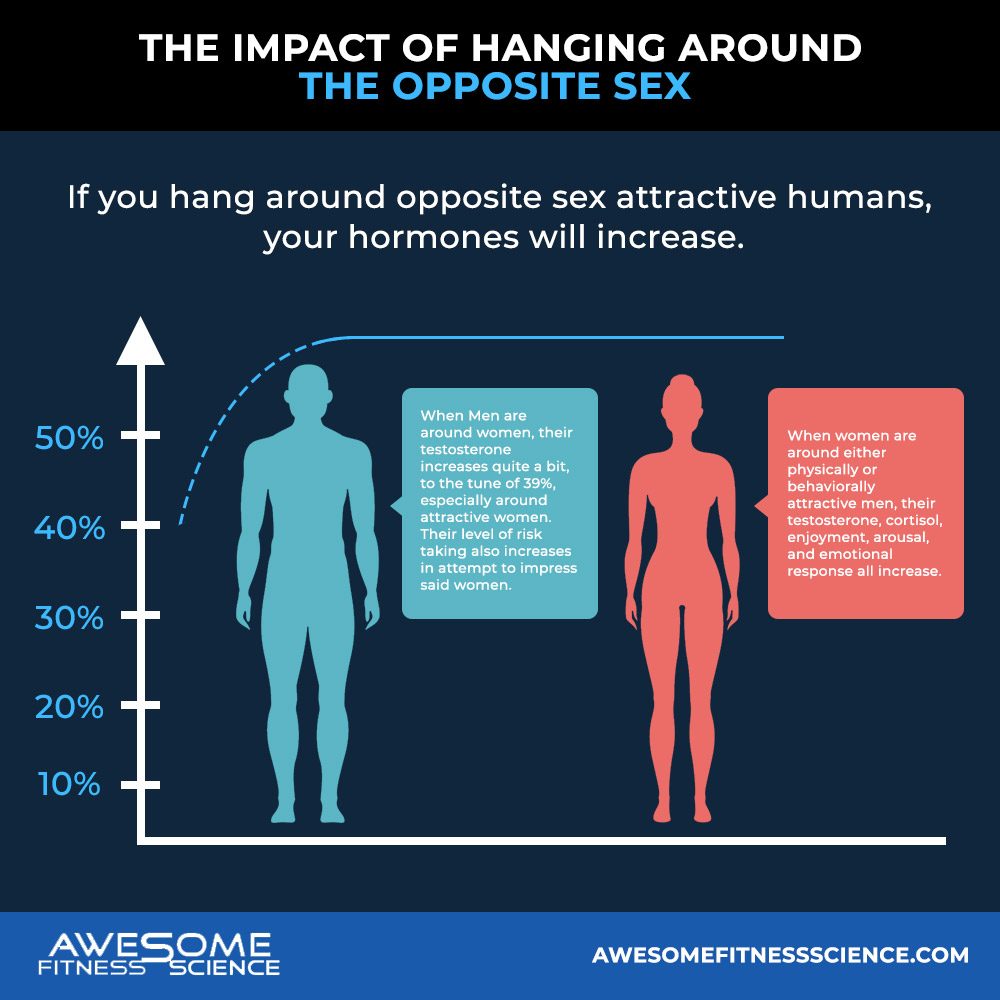
Some skepticism may be warranted. My experiment was only done on myself and was quite informal.
But if basic lifestyle factors have been mastered, I still feel pretty confident encouraging you to focus on proper supplementation, nasal breathing, and having a healthy social life. These can all contribute to noticeably better testosterone levels and a healthier life.
1. M;, Fui. “Lowered Testosterone in Male Obesity: Mechanisms, Morbidity and Management.” Asian Journal of Andrology, U.S. National Library of Medicine, pubmed.ncbi.nlm.nih.gov/24407187/.
2. Bhasin, Shalender, et al. “Testosterone Dose-Response Relationships in Healthy Young Men.” American Journal of Physiology-Endocrinology and Metabolism, 1 Dec. 2001, journals.physiology.org/doi/full/10.1152/ajpendo.2001.281.6.E1172.
3. Gani, Linsey Utami, and Choon How How. “PILL Series. Vitamin D Deficiency.” Singapore Medical Journal, Singapore Medical Association, Aug. 2015, www.ncbi.nlm.nih.gov/pmc/articles/PMC4545131/.
4. Pilz . “Effect of Vitamin D Supplementation on Testosterone Levels in Men.” Hormone and Metabolic Research = Hormon- Und Stoffwechselforschung = Hormones Et Metabolisme, U.S. National Library of Medicine, pubmed.ncbi.nlm.nih.gov/21154195/.
5. ME. Angeline, AO. Gee, et al. “Prevalence of Vitamin D Inadequacy in Athletes: A Systematic-Review and Meta-Analysis.” Sports Medicine, Springer International Publishing, 1 Jan. 1970, link.springer.com/article/10.1007/s40279-014-0267-6.
6. DT;, Papadimitriou. “The Big Vitamin D Mistake.” Journal of Preventive Medicine and Public Health = Yebang Uihakhoe Chi, U.S. National Library of Medicine, pubmed.ncbi.nlm.nih.gov/28768407/.
7. Prasad . “Zinc Status and Serum Testosterone Levels of Healthy Adults.” Nutrition (Burbank, Los Angeles County, Calif.), U.S. National Library of Medicine, pubmed.ncbi.nlm.nih.gov/8875519/.
8. M;, Cordova. “Behaviour of Zinc in Physical Exercise: a Special Reference to Immunity and Fatigue.” Neuroscience and Biobehavioral Reviews, U.S. National Library of Medicine, pubmed.ncbi.nlm.nih.gov/7566745/.
9. Maggio . “The Interplay between Magnesium and Testosterone in Modulating Physical Function in Men.” International Journal of Endocrinology, U.S. National Library of Medicine, pubmed.ncbi.nlm.nih.gov/24723948/.
10. HC;, Nielsen. “Update on the Relationship between Magnesium and Exercise.” Magnesium Research, U.S. National Library of Medicine, pubmed.ncbi.nlm.nih.gov/17172008/.
11. M;, Walker. “Mg Citrate Found More Bioavailable than Other Mg Preparations in a Randomised, Double-Blind Study.” Magnesium Research, U.S. National Library of Medicine, pubmed.ncbi.nlm.nih.gov/14596323/.
12. Lopresti, Adrian L, et al. “A Randomized, Double-Blind, Placebo-Controlled, Crossover Study Examining the Hormonal and Vitality Effects of Ashwagandha ( Withania Somnifera) in Aging, Overweight Males.” American Journal of Men’s Health, SAGE Publications, 2019, www.ncbi.nlm.nih.gov/pmc/articles/PMC6438434/.
13. Mahdi, Abbas Ali, et al. “Withania Somnifera Improves Semen Quality in Stress-Related Male Fertility.” Evidence-Based Complementary and Alternative Medicine : ECAM, Hindawi Publishing Corporation, 29 Sept. 2009, www.ncbi.nlm.nih.gov/pmc/articles/PMC3136684/.
14. Wankhede, Sachin, et al. “Examining the Effect of Withania Somnifera Supplementation on Muscle Strength and Recovery: A Randomized Controlled Trial.” ResearchGate.
15. BA;, Löth. “Improved Nasal Breathing in Snorers Increases Nocturnal Growth Hormone Secretion and Serum Concentrations of Insulin-like Growth Factor 1 Subsequently.” Rhinology, U.S. National Library of Medicine, pubmed.ncbi.nlm.nih.gov/9923061/.
16. M;, Schwab. “Filtration of Particulates in the Human Nose.” The Laryngoscope, U.S. National Library of Medicine, pubmed.ncbi.nlm.nih.gov/9432080/.
17. Richard Ronay, William von Hippel. “The Presence of an Attractive Woman Elevates Testosterone and Physical Risk Taking in Young Men – Richard Ronay, William Von Hippel, 2010.” SAGE Journals, journals.sagepub.com/doi/abs/10.1177/1948550609352807.
18. PH;, López. “Attractive Men Induce Testosterone and Cortisol Release in Women.” Hormones and Behavior, U.S. National Library of Medicine, pubmed.ncbi.nlm.nih.gov/19303881/.
19. J. Altmann, R. Sapolski, et al. “Tandem Androgenic and Psychological Shifts in Male Reproductive Effort Following a Manipulated ‘Win’ or ‘Loss’ in a Sporting Competition.” Human Nature, Springer US, 1 Jan. 1995, link.springer.com/article/10.1007%2Fs12110-018-9323-5.
Grab my free Stupid Simple Scroll to Mastering Hypertrophy

For decades, bodybuilders have advocated for the mind muscle connection which refers to aiming your focus towards the targeted muscle you’re training.

Which Makes You Fatter? Carbs or Fat? When it comes to the three macronutrients, protein is like the golden child. It’s the one that does

Weights vs machines is a face palm worthy debate, especially when you see dorks claim free weights are better and manlier.